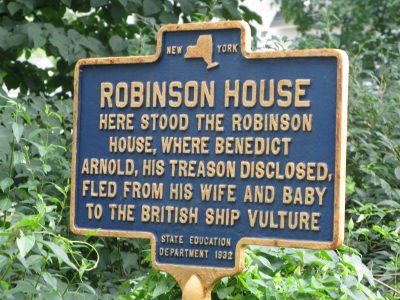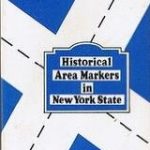
I had an epiphany at the annual conference of the Association of Public Historians of New York State (APHNYS). That probably is not a venue normally associated with religious breakthroughs. Nonetheless, I had a vision of history signs and it was good. Standing at the vendor booth for the Pomeroy Foundation, which funds history signs throughout the state, I realized that our state history signs are like lost sheep wandering around the state but no one knows where.
What do I mean, they are lost? Everyone knows where they are. Everyone sees them. Well, yes, it is true, it is difficult to drive too far along the highways and byways of the Empire State without encountering a history marker, but that doesn’t mean anyone knows where all such signs are.
Let’s review the history of history markers in state courtesy of “Signs of Controversy” by Laurence M. Hauptman from the summer 2014 issue of the NYS Archives Trust bulletin. Here are the critical dates in the history of the history markers:
Stage 1 (1926) The Commemoration of New York’s role in the American Revolution
The State Legislature directs the State Commissioner of Education plan for the commemoration of the 150th anniversary of the American Revolution including a provision for “markers to designate sites that are of historic interest in the colonial, revolutionary, or state formative period.” So was born the famous gold-rimmed blue markers that continue to line our roads to this very day. Over 200 were erected in the following decade. Hauptman notes that the American Indian did not fare well in the reporting on these signs. An inventory of those signs can be found at the APHNYS website in a downloadable PDF which I just downloaded.
Stage 2 (1939-present) Signs Go Wild
Obviously Hauptman’s term is not a legal or official one. It refers to cessation of state funding for and control over the history markers. All state controls were eliminated. Anything was possible.
Stage 3 (1960-1966) Historical Area Marker Program
At this point, the State sought to resume control. History markers were to serve dual purposes: education and tourism. Signs were to be located along the New York State Thruway at rest stops and on other major highways. The signs were to be oversized with different font from the original state makers to differentiate them. Imagine that: big state history signs on the highways to promote tourism starting in 1960…and to be controlled by the State Education Department. Does that sound familiar? These signs happened 52 years before I Love NY wrested control of the oversized Path through History signs on the highways from the State Education Department/New York State Museum which originally controlled the project. In trying to understand the shift in responsibility, please keep in mind that the State Education Department reports to the Regents while I Love NY reports to the Governor, not that politics was a factor in any of the decision-making. I did a search on the New York State Museum website and found a documented listing of 139 Historical Area Markers erected in the 1960s.
Stage 4 (1966)
In 1966, the legislature repealed the Historical Area Marker Program. Henceforth, the New York Historic Trust, an advisory group part of the Department of Conservation (now Department of Environmental Conservation). Then in 1972, the legislature shifted the “long-dormant roadside marker program” to the New York State Board for Historic Preservation within the newly-formed Department of Parks, Recreation and Historic Preservation. In the interim, the still extant Office of State History published the Historical Area Markers in New York State guidebook [paperback version of the 1970, publication available on Amazon for $49.99].

There still was no state funding. Responsibility for the approval, removal, correction, and funding of history markers remained local.
Stage 5 2014-2015 The Weible Years
Hauptman’s article from 2014 refers to an initiative begun in 2014 by the then State Historian Bob Weible. The goal was to encourage locally-appointed historians to work cooperatively to coordinate history marker activities and to assume greater responsibility for them. The effort was to be done through APHNYS with the assistance of the Pomeroy Foundation. I did not know this when I had my epiphany. I was aware of a New York State website listing history markers by county. When I looked at it months ago for my own county, Westchester, I found, not surprisingly that Weible was still listed as the contact person even though he was no longer there. When I just looked again, I couldn’t even find the page on the NYS Museum website. I did, however, find a reference to it in Wikipedia under List of New York State Historic Markers.
According to Wikipedia there are over 2800 such signs through 1966 with a breakdown provided by county. One can drill down on each county to obtain a more detailed list with date, location, and inscription. The source for the information was the very webpage I was searching for. When I clicked on the link the response was
Our apologies, but much like the Cohoes Mastodon,
this page is history.

New York Net History Net also has a link to the New York State Museum listing with the same result. That website apparently is not up-to-date as it refers to an upcoming conference in 2004:
State History Interest Project (SHIP) – clubs for middle school and high school students interested in New York State, formerly known as Yorkers. New clubs are welcome at the next annual convention May 6-8, 2004 in Niagara Falls, NY.
Although not the subject of this post, the Yorkers link leads to:
404 – File or directory not found.
The resource you are looking for might have been removed, had its name changed, or is temporarily unavailable.
What ever happened to this statewide effort to engage students in New York State history? And please don’t say National History Day.
Returning to the history markers, Hauptman advocates for a change in the obviously defunct system that became even worse since his 2014 article. He observes that there is no state agency authorized by the legislature to correct, replace, or remove existing signs.
It’s not as if the State Museum isn’t aware of the situation. On its own website there is a summary of history markers by Philip Lord. Much of the information parallels the Hauptman article with additional details identifying specific legislation.
Lord provides the following description for the wild years:
In the 1960s & 70s, staff of the Office of State History consulted with the field, primarily via the network of local government historians at the county and town level, and encouraged the installation of historic markers, with SED staff reviewing the proposals. There was no funding, and the relationship with the field was more consultative than regulatory. However, the staff was moderately aggressive in making sure that all persons wishing to erect a marker went through this process, and people were given a letter of approval.
He then notes that:
Unlike many other states, New York State does not currently manage a historical marker program. Instead, local authorities are responsible for the approval, installation, and maintenance of historical markers. Anyone interested in placing or repairing a marker should thus check with appropriate county, city, town, or village historians or officials.
In effect, it is incorrect to refer to the new signs as state signs since the state has no control over them.
There are still new history signs being established all the time. For example:
May 21, 2016 The Margaret Fuller Marker Dedication in Beacon – funding was by the Pomeroy Foundation which seemingly has replaced the state in any overseer role at least for the signs it funds and they do resemble the famous state sign format
August 18, 2016 914 The Sound Recording Studios Historical Marker Dedication where some of the most iconic rock anthems of the 1970s were made, including Bruce Springsteen’s “Born to Run” and Janis Ian’s “At Seventeen.”
October 7, 2016 The Greenwich Village Society for Historic Preservation (GVSHP) placed its ninth plaque (not history marker) at the former home and studio of renowned 20th century sculptor and artist Chiam Gross at 526 LaGuardia Place (at Bleeker Street), now the home of the Renee and Chaim Gross Foundation.

Strange as it may seem. there are people interested in history signs the way other people are fascinated by the Kardashians. New York Historic was founded by Matthew Conheady. Its website states the following:
We are not the New York State Office of Parks and Historic Preservation (go there instead). We are not in charge of or responsible for any of the historic sites listed on this website.
We are a band of photographers with an interest in New York State history. The nature photography community, NYFalls.com – Upstate Nature, Wildlife and Photography, owns and operates this website.
What we do
We geographically catalog Historic Sites around the state of New York, and present them online for people to explore. Our database is complemented by beautiful photos taken by talented members of our community.
Why we do it
Just as NYFalls.com has inspired aspiring photographers to get out and tour Upstate New York to capture beautiful waterfall and lake scenes, NYHistoric aims to help people locate these interesting sites, so they can have new photography subjects to explore and learn a bit of local history as well.
We also expect the education and tourism industries to take advantage of our efforts.
We do it all for free, and because we like to.
Another example is:
New York State Historical Markers: It Happened Here
created by Tom Arthur. The last entry is dated September 16, 2016, so it appears to still be functioning.
So what should be done now?
Goal: Create a documented and searchable statewide database of the history markers in New York State starting with the state- sanctioned signs.
- The Governor through the Office of the State Historian should ask each county executive/borough president acting through the county historian/borough historian to prepare a list for the county/borough.
- The County historian/borough historian should work through the municipal historians and historical societies to create Yorker clubs with the first task to be inventorying the history markers in the municipality.
- The inventory should include photographs, then and now if appropriate, GPS information, and a review of the information on the current signs to check for accuracy. It may be necessary to replace some signs with better information.
- The New York State Archives/Museum should locate the original applications for state history markers.
- The New York State Historian should create a state map and database of the history markers.
It might be reasonable to test this at the county level first. For example, in 2015, Otsego County, which does not have a county historian, produced a booklet “Historical Markers of Otsego County and Their Locations” under the auspices of the Otsego County Historical Association. I thank Town of Hartwick municipal historian Carol Goodrich whom I saw at the APHNYS conference where this all began, for mailing me a copy. Now what we need is some state leadership to bring together APHNYS, Pomeroy, NY Historic, NYS Historical Markers, the NYS Archives, and the NYS Museum together to make it happen.





